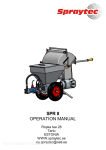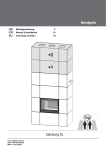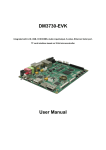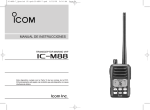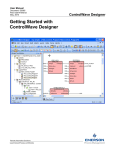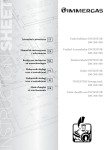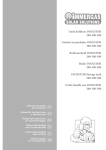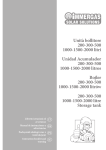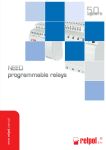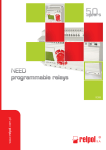Download Moderator UNICA SENSOR 10 ÷ 60kW Boilers Operating Instructions
Transcript
Moderator Spółka z o.o. Ul. 11 Listopada 16a 17-200 Hajnówka POLAND www.moderator.com.pl Moderator UNICA SENSOR 10 ÷ 60kW Boilers Operating Instructions TABLE OF CONTENTS Dear User, ............................................................................................................................... 3 1. Overview ............................................................................................................................ 3 1.1. Safety Instructions ........................................................................................................... 3 1.2. Warranty Terms and Conditions .................................................................................... 5 1.3. Fuel .................................................................................................................................. 6 1.3.1. Burning Other Fuels ..................................................................................................... 7 1.4. Technical Description ..................................................................................................... 7 1.5. Equipment ....................................................................................................................... 8 2. Installation .......................................................................................................................... 8 2.1. General parameters .......................................................................................................... 8 2.2. Boiler Room .................................................................................................................. 11 2.3. Boiler Installation .......................................................................................................... 11 2.4. Connecting to the Chimney ........................................................................................... 11 2.5. Boiler connection to the central heating system............................................................ 12 2.6 Connecting the boiler to electric installation.................................................................. 13 2.7. Protection of the Installation ......................................................................................... 19 2.7.1. Open systems.............................................................................................................. 19 2.7.2. Closed Systems .......................................................................................................... 20 2.7.3. Thermal protection ..................................................................................................... 22 3. Boiler operation ................................................................................................................ 23 3.1. Controller – description, operation, servicing ............................................................... 23 3.2. Igniting .......................................................................................................................... 25 3.3. Burning .......................................................................................................................... 25 3.4. Boiler and Chimney Cleaning ....................................................................................... 26 3.5. Planned shutdown of the boiler ..................................................................................... 28 3.6. Emergency Shutdown of the Boiler .............................................................................. 28 4. Boiler Troubleshooting .................................................................................................... 29 4.1. Maintenance and overhauls ........................................................................................... 29 5. Safe operation conditions ................................................................................................. 29 6. Disposal ............................................................................................................................ 31 7. Connecting the boiler to automatic feeders ...................................................................... 31 7.1. The boiler may be used with Automatic Biomass Burning Feeders “Smok” ŻL and GC ........................................................................................................................................ 31 7.2. Boilers intended for pellets burners .............................................................................. 32 8. Boiler specifications ......................................................................................................... 33 Due to on-going research & development work, the manufacturer reserves the right to make boiler design and documentation changes. Consequently certain elements of the boiler, as presented on photographs or drawings in these instructions may differ from elements as in delivered unit. 2 Dear User, Thank you for your purchase of our equipment and congratulations on your good choice. Moderator Spółka z o. o. has been manufacturing boilers utilizing proprietary technological solutions developed in late 70’s in Hajnówka by engineer Mr Kazimierz Kubacki. For almost thirty years these boilers have been undergoing multiple technological changes and upgrades. This instruction manual is based on the latest information of the manufacturer. Due to ongoing development works on the boiler the manual is only applicable for the boiler it is delivered with. Moderator boilers are intended for heating water up to maximum temperature of 90 degrees Celsius in central-heating and hot household water installations as well as in process installations (wood dryers, presses, etc.). This manual has been designed to assist users in boiler installation, operation, maintenance and servicing. It shall be read and understood before commencing with these activities. 1. Overview 1.1. Safety Instructions The main condition of safe boiler operation is its correct connection to the central heating installation. The manufacturer has undertaken all efforts to ensure safe operation of the device. This will only be possible after all connection and operation requirements discussed in these instructions are met and complied with. Failure to perform any action, due to involved costs of additional equipment installation will certainly affect the safety or cause the equipment operating costs to raise in future. All performance tests and trials of boilers have been performed using carefully selected accessories (safety valves, thermal protections) and equipment (air supply systems). In order to guarantee maintenance of declared high performance of the boiler, manufacturer-recommended equipment must be used exclusively. We would like to hereby advise against using substitute solutions, which have not been checked with that boiler and which do not have required approvals (Technical Supervision Office - UDT) and certificates (declaration of conformity, CE sign). We also advise against any unauthorized changes in the boiler design. Failure to follow these recommendations may lead to serious threats and expose the operating personnel to health or life hazard. 3 In case of doubt, please consult our sales department or authorized servicing agent. Safety and Warning Signs Note: The washout located under the masking cover may be hot. Pay special attention in the boiler room, as other parts of the boiler and the installation may also be hot.. This sign in this manual indicates a danger. Please carefully read the corresponding section so as to avoid dangerous situations in future. Keep in mind that in the boiler room various surfaces may have different temperatures. You have to pay special attention to the fact, that temperature of doors may be significantly higher than the temperature of other boiler surfaces. This also applies to the smoke breeching and supply and return piping. When in boiler room, always pay special attention. Keep in mind that ashes and fuel (in particular dry sawdust and chips) may cause allergic reactions. We recommend wearing protective gloves and dust masks. Keep the boiler room clean. Fuel left or spilled on the floor may cause a fire. 4 1.2. Warranty Terms and Conditions 1. 2. 3. 4. 5. 6. 7. Manufacturer grants 36-month warranty for the unit, which covers all workmanship and material faults. Manufacturer warrants fault-free operation of the central heating, which is further attested by the production plant’s seal. Manufacturer requires the guidelines below to be followed: • the first starting of the unit shall be performed by the manufacture’s technical support representative The warranty shall not include damages resulting from misuse or normal wear and tear, refund of assembly costs, travel costs, damages resulting from modifications or repairs implemented or performed without manufacturer’s consent, indirect and consequential damages, production outage related losses or any other economic loses co caused. The warranty shall not include faults resulting from: • failure to follow assembly guidelines stated in these operating instructions or resulting from regulations currently in force, • incorrect servicing or maintenance or effects of boiler operation in a way, which is incompatible with its operating instructions’ provisions (use of incorrect fuel, leaving ash after the heating season, faults resulting from central heating installation freezing, incorrect or blocked flue system, loss of water in the installation) • utilization of the boiler for purposes other than its intended use, as specified in the operating instructions • in case of incorrect selection of the boiler output to the object’s heat demand All warranty claims must always be sent to the boiler seller. Before submitting a claim, please make ready the following details: • photocopy of page 5 of the operating instructions, item 1.2. (with entered date and legible signature of the user) • description of the fault • a document to prove the equipment purchase • boiler rated power • serial number User statement: I hereby declare to have acknowledged myself with the Moderator boiler operating instructions and I hereby confirm that the equipment was delivered as ordered, new, complete and technically operational. Above that a specialized company presented to me principles of the equipment operation and provided a complete set of documentation. I hereby accept the Moderator boiler manufacturer’s recommendations. In case of an unjustified service request to the Moderator company under a warranty repair, I undertake to bear all related costs (man hours and costs of shipping to and from the service centre) up to their full amount. Date, company name or first and last name legible signature 5 Declaration of Conformity We, Moderator Spółka z o.o. Ul. 11 Listopada 16a 17-200 Hajnówka, POLAND tel. +48 (0)85 682 75 20 hereby declare under our own and sole responsibility that the product: MODERATOR central-heating boiler, serial nos. from 400, to which this declaration applies, meets the following requirements and standards, as applicable: Directives 97/23/WE Standards EN-PN- 303-5 Hajnówka, on 2004.02.01 1.3. Fuel Use only fuels recommended by the manufacturer. The Moderator boiler is designed to burn renewable fuels, wood-based and vegetable fuels (pieced wood, chips, sawdust, bark) with moisture content of up to 30%. Coal may be used as a substitute fuel Technical parameters of the boiler are specified for fuels with humidity content of up to 30% and calorific value of Q=17.084 kJ/kg for wood and Q=29.924 kJ/kg for coal. The higher the moisture content, the lower the calorific value (note: an increase of moisture content causes calorific value to drop, which means that one will need twice as much fuel to achieve the same heating effect). A considerable part of thermal energy is wasted in the burning process for heating up the fuel and evaporating water (note: using wet fuel directly contributes to shortening of boiler’s operational life and causes it to wear out prematurely). Hygrometers are used for moisture content measurements (different types are used for sawdust and different for wood) and these are necessary equipment, which should be used when purchasing fuel (to check the actual moisture content) as well as during normal operation of the boiler. 6 1.3.1. Burning Other Fuels Uncontaminated paper and cardboard may only be used for igniting fire in the boiler. Mixtures of various clean paper and cardboard may only be burned with wood. Papers and magazines must not be burned and should be recycled. One shall keep in mind that impregnates, inks and other components used for their production will significantly pollute the natural environment. We also advise against burning plastics in various forms. Keep in mind that smoke generated during combustion of plastics will contain substances, which are poisonous and harmful to human and that these substances will fall down in direct vicinity of the chimney. Do not burn PVC products under any circumstances, e.g.: - butter or margarine boxes - transparent plastic bottles - jewel boxes (cassettes/CDs) or toys - plastic building materials - polyamide (PA) products, such as textiles Some plastics identified as PE, PP, PET may be burned, provided that their volume does not exceed 5% of the fuel volume (e.g. of wood) and the combustion temperature is not lower than 850o C. Approximate data of different fuels Fuel type wood pieces chips sawdust bark coal Burning time ( h) 4-6 3-5 2-4 2-5 6-8 1 cubic meter weight ( kg ) 404 215 238 250 900 moisture content (%) 15 15 15 15 - 1.4. Technical Description This manual applies to boilers rated from 10 to 60 kW manufactured in the plate version. Moderator boilers (Fig. 1) are boilers operating in the top-burning system. Walls and grate are water cooled (the version supporting burners may be equipped with cast iron grate) and made of quality sheet metal plates. Manual, top fuel charging, mechanical ash removal from the grate, bottom doors (ash pan 7 doors) equipped with mechanical air supply throttle (used in case of a power outage or in versions without an air supply system). Boilers are equipped with directional air supply to the combustion chamber with autogenous primary and secondary air distribution. On its way to the combustion chamber air is heated. This significantly contributes to correct burning process. 1.5. Equipment The boiler is delivered in assembled state. Its standard equipment includes a thermometer* and a cleaning kit. Other, additional elements depend on the purchased version and are not included in the boiler price. The ash tray is only available for 10-25kW models. Additional non-fixed equipment: - G ½ drain valve - G ¾ safety valve (G ½ for 10 and 15kW boilers ) - SYR 5067 thermal protection * in 40-60kW boilers, the thermometer is installed on the control panel, so additional thermometer needs not to be installed. The electric control system is installed on the boiler housing and connected. The blower installed on the top part of the boiler housing and is connected through the primary and secondary air circulation and requires no user adjustments (for detailed information on the air supply system, see section 7 and operating instructions delivered with the boiler). 2. Installation 2.1. General parameters Maximum supply temperature – 90˚C Maximum return temperature – 70˚C Minimum recommended return temperature – 55˚C Operating pressure - 1.5 bar Thermal efficiency (in case of manual charging): for wood – 78.7% for coal - 80% Minimum combustion gases temperature – 150o C 8 8 13 12 9 6 1 2 3 5 4 1. 2. 3. 4. 5. 6. 7. 8. 9. 10. 11. 12. 13. 11 7 10 Charging flap Grate doors Ash-pan doors Air throttle Mobile grate lever Fan Return pipe Top washout cover (20 and 25kW boilers) Supply pipe Ash pan washout cover Straight-through valve G½ muff Tech ST-81 controller (10 to 30kW boilers) G½ muff Fig.1a. Unica SENSOR 25 kW boiler – description of main parts. 9 8 9 12 13 6 1 2 3 5 4 1. 2. 3. 4. 5. 6. 7. 8. 9. 10. 11. 12. 13. 11 7 10 Charging flap Grate doors Ash-pan doors Air throttle Mobile grate lever Fan Return pipe Top washout cover (20 to 60kW boilers) Supply pipe Ash pan washout cover Thermometer ecoMAX 200 controller (40 to 60kW boilers) G½ muff Fig.1b. Unica SENSOR 50 kW boiler – description of main parts 10 2.2. Boiler Room The boiler room shall meet requirements of the PN-87/B-02411 standard. Here are some of the most important of them: • waterproof flooring • steel or wooden doors lined with sheet metal, opening outwards • 21x21 cm air supply hole in the bottom part of the boiler room • at least 14x14 cm exhaust hole in the upper part of the boiler room Equipment: • tap • sewage well • sing Forced ventilation must not be used. 2.3. Boiler Installation Boiler installation shall be performed by an engineer with appropriate qualifications and experience (we advice you to seek help from representative centres, whose installers have undergone training in Moderator Sp. z o.o.). A faulty installation may cause premature wear of the boiler and threatens fire or may cause an explosion. Moderator boilers are delivered in assembled state. Boiler may be positioned directly on the floor with 1 gradient towards the front wall (the top point of the boiler after the installation shall be the place close the supply pipe). During boiler installation, it is necessary to ensure its accessibility in such a way, so that boiler room walls do not render fuel charging, grate cleaning and access to the side washout and fan difficult. Recommended distances are: min. 80cm for side walls and 100 cm for the front wall. 2.4. Connecting to the Chimney Boiler’s smoke breeching shall be seated directly in the chimney, and after installation sealed along the contact line of: smoke breeching sheet metal – chimney brick. It is necessary to ensure access to washout doors installed on side walls of the smoke breeching, which are intended for boiler’s rear part cleaning. Chimney outlet shall be located 75 cm above the roof ridge. Square or rectangular chimneys shall be made of burnt brick; round chimneys (usually 11 steel ones) shall be insulated over the whole height with at least 5-cm mineral wool layer. When installing the smoke breeching in the chimney, one shall pay attention to the chimney damper lever (it is necessary to provide a space needed for its easy opening and closing). Remember that combustion gases entering the chimney are hot, therefore the chimney damper lever will heat up. To operate the chimney damper, always wear protective gloves. Required Chimney Cross-Section Dimensions Power kW square chimney rectangular chimney round chimney chimney height cm x cm cm x cm diameter (cm) (m) up to 15 18 x 18 14 x 27 18 6÷8 20 ÷ 32 20 x 20 14 x 27 24 8 ÷ 10 40 ÷ 50 25 x 25 - 28 8 ÷ 10 60 ÷ 150 30 x 30 - 35 8 ÷ 10 2.5. Boiler connection to the central heating system The boiler is manufactured as an all-round unit that facilitates of various types of connections. Please make sure that all unused holes and outlets are plugged. The Boiler will operate correctly if the temperature inside the combustion chamber will be sufficiently high, which means that the supply water (on the boiler output ) shall have the temperature in the range of 70 to 80O C, and that the water on return, not less than 55O C. Such operating parameters will protect the boiler against low-temperature material corrosion. Boilers have connections in the form of threaded G1½ stub pipes. Connecting stub pipes with the installation shall be performed using appropriate connectors. In order to properly connect the boiler, it is necessary to install all accessories presented on Figures 1a and 1b. If the boiler is fitted with a thermal safety valve, the valve’s sensor shall be installed in the dedicated G½ muff (item 13 on fig.1a,b), then install the safety valve. 12 In order to ensure correct operation of the boiler, manufacturer recommends installation of a four-way mixing valve or a heat accumulation tank. (Fig. 2) Pompa CWU – Hot houtehold water pump Pompa M – M Pump Fig.2. Sample installation with a four-way mixing valve. Connect water supply pipe through the G½ valve (11, fig. 1a) using a flexible hose, which after filling is completed shall be disconnected. When filling open all venting valves in the installation and slowly close them until water overflows in the overflow pipe of the expansion vessel (in case of open systems). Lossless installations may be supplied with raw water, as long as its hardness is less than 10 n. Otherwise the water shall be pre-treated. Install boiler accessories (handles and bakelite knobs ). 2.6 Connecting the boiler to electric installation Electric installation and connection principles. 1. Before connecting the device, it is necessary to read boiler’s and controller’s operating instructions. 13 2. Before commencing with assembly, repair or maintenance works and when performing all connections, it is necessary to disconnect power supply from the device and verify that power lines are disconnected from mains. 3. Boiler house shall be equipped with 230V/50Hz electric installation, compatible with relevant regulations applicable in this scope. 4. The electric installation (regardless of its type) shall be terminated with a power receptacle equipped with a protective earth terminal. Use of power receptacles without properly wired protective earth terminal will constitute electric shock hazard!!! 5. The boiler shall be connected to a separately installed power supply line, protected with suitably chosen fast-blow fuse and differential-current circuit breaker (shock protection). The value and the type of the fuse is defined in the controller’s operational documentation. No other equipment must be connected to this line. 6. The box, in which electric accessories are contained, may only be opened by a competent electric engineer, knowledgeable with the equipment operation. 7. Location of the power receptacle used for the boiler connection shall be selected in such a way so that the plug is easily accessible to allow quick boiler disconnection in case of an emergency. 8. Wires shall be routed away from the parts of the boiler that may get hot, and in particular away from hot elements of the flue breeching. 9. The controller must not be exposed to flooding or to conditions causing vapour condensation, e.g. rapid ambient temperature changes. 10.The controller must not be operated if its enclosure is damaged. 11.Protect the controller against access of children. 12.During thunderstorms, the controller shall be disconnected from mains. 2.6.1 Boilers rated 10 to 30 kW Unica SENSOR boilers rated 10 to 30 kW have preinstalled air supply system, which consists of the following elements:. A B C (ref. fig. 3). Other parts used to connect power supply and pumps driven by the controller are located in the box attached to the boiler. 14 A B C A. Blower B. Connecting cable C. Tech ST-81 controller Fig.3. Air supply system (the photo shows a 20 kW rated boiler). Connecting power supply The boiler is connected to the power supply network by inserting one end of the power supply cord (delivered with the boiler) to the electric power supply receptacle 1 (Fig. 4). The other end, terminated with the power plug must be inserted into an outlet of the electric power supply installation. In case of a damage to the power supply cord, replace it with a cord of the same type. Connecting central heating circulating pump This operation shall be performed by a person with necessary qualifications to perform electric installation works. Connect the circulating pump to 4 (Fig. 4.) socket, identified as “POMPA co” using a cable with cross-section of at least 3x0.75mm2 using suitable socket (included). 15 Connecting domestic hot water pump This operation shall be performed by a person with necessary qualifications to perform electric installation works. The pump used to charge the household hot water tank shall be 2 connected to the socket (Fig. 4.) identified as “Pompa cwu”, using a cable with crosssection of at least 3x0.75mm2 using suitable socket (included). The household hot water tank’s temp. sensor 3 shall be connected to the socket located above the power supply socket. 1. Power supply socket 2. Hot household water pump socket 3. Household hot water temperature sensor socket 4. Central heating pump socket 5. Fuse 2 1 3 4 5 Fig.4. Tech ST-81 controller – rear view. 16 2.6.2 Boilers rated 40 to 60 kW Unica SENSOR boilers rated 40 - 60 kW have preinstalled air supply system, which consists of the following elements: A B C (see fig. 5).. A B C A. Dmuchawa B. Przewód łączący C. Sterownik z regulatorem ecoMAX 200 Fig.5. Air supply system (the photo shows a 40 kW rated boiler). Other parts used to connect power supply and pumps driven by the controller are located in the box attached to the boiler. 1 2 3 4 5 6 Fig.6. Controller sockets – rear view. Fig. 6 shows the real panel of the controller, where the following sockets are located: 1. Local thermostat 2. Hot household water temperature sensor 3. Hot household water pump 17 4. Central heating pump 5. Air blower 6. Power supply socket Connecting power supply The boiler is connected to the power supply network by inserting one end of the power supply cord (delivered with the boiler) to the socket 6 (Fig. 6.) marked as “230V~ 50Hz”, which is located on the controller enclosure. The other end, terminated with the power plug must be inserted into an outlet of the electric power supply installation. If the power supply cord is damaged, it shall be replaced with a cable of the same type, with wires’ cross-section of at least 3x0.75mm2. The maximum, combined loading of 3 4 5 outputs is 3A. Connecting the central heating circulating pump This operation shall be performed by a person with necessary qualifications to perform electric installation works. The circulating pump shall be connected to 4 socket using a cable with cross-section of at least 3x0.75mm2. While making the connection, the pump cable shall be terminated with a computer-type plug (included). Connecting the hot household water pump This operation shall be performed by a person with necessary qualifications to perform electric installation works. The pump that charges the hot household water tank shall be connected to the socket, 3 using a cable with cross-section of at least 3x0.75mm2. While making the connection, the pump cable shall be terminated with a computer-type plug (included). Temperature sensor of the hot household water tank shall be 2 connected to input no. . Connecting the local thermostat This operation shall be performed by a person with necessary qualifications to perform electric installation works. The local thermostat shall be connected to socket 1 of the controller, terminating its cable with a RCA plug (included with the boiler). Operation of the controller when fitted with the local thermostat is described in the PLUM ecoMAX 200 controller documentation. 18 2.7. Protection of the Installation 2.7.1. Open systems Moderator boilers operating in open central heating systems must be connected according to requirements of the PN-91/B-02413 standard, so that excess heat in the form of steam shall be removed through an open connection (RP overflow pipe) to atmosphere Fig.7. Installation protection for boilers operated in open central-heating installations KOMIN – CHIMNEY CZUJNIK TEMPERATURY – TEMPERATURE SENSOR STEROWNIK – CONTROLLER ZAWÓR SPUSTOWY – DRAINAGE VALVE ZAWÓR MIESZAJĄCY– MIXING VALVE WĘŻOWNICA - COIL ZASILANIE Z SIECI - WATER PIPE SUPPLY ZAWÓR BEZPIECZEŃSTWA - SAFETY VALVE KOCIOŁ – BOILER WENTYLATOR – BLOWER NACZYNIE WZBIORCZE – PRESSURE VESSEL ZBIORNIK AKUMULACYJNY – HEAT ACCUMULATION TANK INSTALACJA GRZEWCZA – HEATING INSTALLATION Installation requirements: • pressure vessel with the volume of at least 4% of the total water charge shape: cylindrical, type A. acc. to PN-91/B-02413-1-2 rectangular, type B, acc. to PN-91/B-02413-1-3 • safety riser tube (RB) with inner diameter of: 25 mm for boilers rated up to 25 kW, inclusively 19 32 mm for boilers rated 40 to 60 kW • riser pipe (RW) with inner diameter of 25 mm • overflow pipe RP inner diameters as RW and RB • circulation pipe (RC) with inner diameter of 20 mm • venting pipe (RO) and signalling pipe (RS) with inner diameters of 15 mm. No fittings permitting complete or partial closure of flow may be installed on RB, RW and RO pipes. The protective equipment and pipes shall be protected against freezing. 2.7.2. Closed Systems Moderator boilers operating in closed systems must be equipped with air supply system (designed by Moderator Sp. z o.o. for Moderator boilers - we advise against installation of other air supply systems) safety valve and additionally thermal protection permitting safe discharge of excessive thermal power. Muffs welded in the upper jacket of the boiler facilitate installation of this equipment (fig.8). Moderator boilers are manufactured according to the PN 303-5 standard, which permits boiler operation in closed systems if specific requirements are complied with. In case of versions adapted for automated operation (only and exclusively with burners), protective systems are sufficient. 5 4 3 1 a) 10 to 15kW 1. 2. 3. 4. 5. 5 5 2 4 2 1 b) 20 to 30kW 3 1 2 4 3 c) 40 to 60kW Supply muff (G1½ 10 to 30kW, G2 40 to 60kW) Safety valve stub pipe (G½ 10 to 15kW, G¾ 20 to 60kW) G½ thermometer stub pipe (in 40 to 60kW boilers must be plugged) The G½ muff of the thermal protection (SYR type) Washout cover Fig. 8. Placement of muffs and stub pipes on the upper panel of Unica Sensor boilers. 20 KOMIN – CHIMNEY ZAWÓR BEZPIECZEŃSTWA - SAFETY VALVE CZUJNIK ZAWORU TERMICZNEGO – THERMAL PROTECTION VALVE SENSOR CZUJNIK TEMPERATURY - TEMPERATURE SENSOR KOCIOŁ - BOILER STEROWNIK – CONTROLLER WENTYLATOR – BLOWER ZAWÓR SPUSTOWY – DRAINAGE VALVE ZABEZPIECZENIE TERMICZNE – THERMAL PROTECTION ZAWÓR MIESZAJĄCY– MIXING VALVE ZBIORNIK AKUMULACYJNY – HEAT ACCUMULATION TANK WĘŻOWNICA - COIL INSTALACJA GRZEWCZA – HEATING INSTALLATION ZASILANIE Z SIECI - WATER PIPE SUPPLY ODPROWADZENIE WODY – WATER DRAINAGE Fig.9. Installation protection for boilers operated in closed central heating systems Special attention shall be paid in case of boiler versions designed for manual charging. The manufacturer’s recommended SYR 5067 thermal protection is only and exclusively effective if pressure in water pipe network can be guaranteed at the min. level of 2.3 bar and if safety valve is installed. This means that the system may not operate if water from in-house water intake is used (e.g. if power supply outage prevents hydrophore switching on), or in places where water supply outages are frequent. In such situations, the boiler shall not be installed in a closed system and its automatic version should be used (which can not burn solid fuels with manual charging). Fig.10. Thermal valve installation diagram. 21 Boiler installation without a reliable device to discharge the excessive thermal power is forbidden. 2.7.3. Thermal protection THERMAL PROTECTION dimensions in mm unless otherwise stated Applications: 5067 thermal protection is designed to protect solid fuel boilers in heating installations fitted with thermostatic valves conforming to the PN-EN303-5 Polish Standard. It is particularly recommended for boilers, which are not equipped with cooling exchanger. Figure 1 presents installation principle, at a close distance from the boiler, with special consideration for such guiding and sizing of pipes so that no pressure losses occur. Installation and operating principle: The 5067 thermal protection valve consists of the following elements: non-return valve (1), pressure reducer (2), thermally-controlled filling valve (3) and ejection valve (4), pressure sensor with a capillary tube(5). The pressure reduction valve (2) is connected to the water pipe network. The output of the thermally-controlled filling valve (3) is connected to boiler’s return line. The supply line to the input of thermally controlled ejection valve (4), which output side leads to the outlet. The pressure sensor is installed in the warmest part, optimally in the upper part of the boiler. The pressure reduction valve is firmly set to 1.2 bar, thus the operating pressure in the heating device shall be by 0.2 to 0.3 bar higher. This prevents opening of the safety valve in the installation. It is recommended to use a safety valve with settings of at least 2 bars. If the preset opening temperature of ca. 90OC is exceeded, the filling valve (3) starts to open. In order to maintain stable pressure in the heating installation, the ejection valve opens at 97OC. After the ejection valve opens, hot water flows out of the installation and cold water may flow in from the supply line, this cools down the boiler. When boiler temperature drops to 94OC, the ejection valve closes. Thermally controlled filling valve and temperature sensor help to restore the correct flow pressure in the heating installation. When the temperature reaches 88°C, also the filling valve closes. Build: The thermal protecting device is controlled by two independent valves: the filling valve and the ejection valve. The body of the device is a die stamped brass element whilst other parts that contact water are made of stainless steel and temperature resistant plastic. All sealing elements are made of resilient and high-temperature resistant, heavy duty elastomeric rubber material. Springs are made of stainless spring steel. The sensor and capillary tube are made of copper, whereas the sleeve is additionally nickel-plated. Valve opening is controlled by doubled temperature sensor. The fittings are self-venting. Elements of the valve, the valve seat and seal may be removed and cleaned without any change to pre-set opening temperature. Compact head of the temperature sensor may be conveniently disassembled during the valve body installation. The capillary tube from the sensor to actuator is protected by a special, metal flexible hose. Pressure reducer operating pressure: Maximum water inlet pressure: Minimum required inlet water pressure : Temperature filling valve ejection valve Maximum operating temperature Capillary tube Weight 1.2 bar (factory-fixed) 16 bar 2.3 bar of opening:: 90°C +0/-2°C 97°C +0/-2°C 135°C 1300 mm – standard length 1.5kg of closing: 88°C +0/-2°C 94°C +0/-2°C 22 3. Boiler operation 3.1. Controller – description, operation, servicing 3.1.1. Boilers rated 10 to 30 kW Figure 11 describes components of the control system with Tech ST - 81 controller. 1 2 1. Tech ST - 81 controller panel 2. Display 3 4 3. Settings buttons 4. Power switch Fig.11. Control system with Tech ST - 81 controller – front view. Detailed information on basic parameters, key functions, parameter setting, etc. are provided in Tech ST - 81 controller operating instructions, delivered with the boiler. Periodical maintenance notes Maintenance activities involve periodic checking of electrical cabling conditions, which is accessible outside the controller enclosure. In case of a mechanical or thermal damage (e.g. molten insulation of wires, broken wire, damaged controller enclosure) it is necessary to stop the device, disconnect it from the electric installation and then proceed to repair the damage. If needed, you may contact the boiler manufacturer. Controller panel must be kept clean and protected against water. 23 3.1.2. Boilers rated 40 to 60 kW Boiler automatic control unit utilizes a microprocessor-controlled PLUM ecoMAX 200 controller. Its task is to maintain the preset temperature in the heating circuit and temperature of hot water in hot household water tank. 1 2 3 1. STB temperature limiter 2. Red control 3. ecoMAX 200 controller panel 4. Display 4 5 6 7 8 5. Settings buttons 6. Power switch 7. Fuse 8. Thermometer Fig.12. Control system with ecoMAX 200 controller – front view Figure 12 describes elements of he control system. Setting buttons 5 are used for specifying controller parameters and for selecting displayed parameters describing the operating status of the boiler control system. For detailed information on basic parameters, key functions, parameter setting methods, etc. see the ecoMAX 200 controller operating instructions delivered with the boiler. On the left side of the panel there is a (Red) control. 2 STB Temperature Limiter 1 prevents excessive water heating in the boiler If it engages (which happens when temperature exceeds 95°C) blower will be switched off. This condition is indicated by illuminating the red control. In order to restore the boiler to normal operation, it is necessary to undo the black nut of the STB temperature limiter and press the pushbutton located underneath. The thermometer shows current temperature, also in case of power outage. 24 Periodical maintenance notes Maintenance activities involve periodic checking of electrical cabling conditions, which is accessible outside the controller enclosure. In case of a mechanical or thermal damage (e.g. molten insulation of wires, broken wire, damaged controller enclosure) it is necessary to stop the device, disconnect it from the electric installation and then proceed to repair the damage. If needed, you may contact the boiler manufacturer. Controller panel must be kept clean and protected against water. 3.2. Igniting Ignition of a cold boiler may only be started after prior checking that the slot is correctly filled with water. Open ash pan doors (or open the throttle on ash pan doors). Ignite using dry wood for about 1.5 hours, gradually reaching the temperature of 80OC. We recommend to perform first ignition without using the air supply system, adjusting the air supply by opening and closing ash pan doors (or the throttle), remembering to switch on the pump after the temperature exceeds 40OC (during further operation, when using the air supply system, the pump coupled with the controller will start automatically). NOTE! For 3 to 4 days, it is recommended to maintain continuous (non-stop) burning in the boiler with the supply water at 70 to 80O C. Further ignitions may be performed by programming boiler operation on the electronic controller, according to principles described in the controller instructions. When igniting, do not fill the whole combustion chamber (for wood - 50% fill rate, for coal - maximum 20% fill rate). 3.3. Burning During normal boiler operation monitor and periodically supplement the fuel. In order to maintain stable temperature of supply water, it is necessary to: • use fuels with moisture contents of up to 30% • in case of higher moisture contents, dry the fuel beforehand or mix it with dry fuel, keeping in mind that the higher is the moisture content of the mixture, the lower is the dose and excess air • when using fuels with varying granulation, charge it alternatively ( fuel with large granules already glowing in the combustion chamber shall be supplemented with fine fuel, e.g. saw dust – as if the sequence is altered, the fine fuel will spill through the grate) • if necessary, avoid opening the charging flap during ignition and while the boiler temperature builds up 25 Note: avoid burning fine fuels, in which dusts concentration exceeds 5%. Pay attention when burning very dry sawdust (moisture content up to 15%), do not compact them tightly in the combustion chamber. Having charged sawdust, leave free space in the rear part of the chamber to ensure air access. Failure to meet these requirements may result with gases from combustion chamber backdrafting during sudden opening of the charging flap. (When the charging flap is opened, this may cause sudden growth of the air volume in the combustion chamber and explosive combustion of dusts.). When operating a boiler with air supply system, do not open the charging flap while the fan is operating. Before supplementing the fuel, switch off the controller. Adjustment of the boiler performance, and thus the supply water temperature shall be performed by changing operational parameters preset on the controller. In exceptional situations (e.g. in case of power supply outage), this can be performed by adjusting the throttle (or the ash pan doors adjustment slot) or by changing the cross-section of the combustion gases outlet in the smoke breeching. When operating a boiler with air supply system, the ash pan flap shall remain closed and it is recommended not to use the throttle. However remember not to block the throttle, as it may act as a safety valve in case of an uncontrolled combustion of gases. If after the blower is started, the throttle flap slightly raises (due to too high draught) it must be pressed down so that it lies flush with the frame The boiler has factory preset hinges. If during boiler starting combustion gases backdraft to the boiler room, then hinges must be pressed down and at the same time the charging flap handle must be adjusted. ! Always make sure that back drafting is not caused by closed flue damper or use of elbows or connectors making flue gases difficult to leave the boiler. 3.4. Boiler and Chimney Cleaning Grate cleaning is performed when water temperature starts to drop and when the ash pan illumination reduces. Ash shall be removed while the flame is reduced. In order to ensure fuel economy, keep internal chambers of the boiler and spaces between water tubes clean. An indication suggesting that cleaning is required is reduced chimney draught. Insufficient air will cause the boiler to smoke excessively. There are washouts installed on side walls of the flue damper. Their purpose is provide access to boiler interior for cleaning. Due to high temperature 26 of surfaces, these washouts may be opened and cleaning may be performed only after the boiler has been shut down. Fig.13. Boiler cleaning diagram. Cleaning may only be performed on boilers that were shut down before. In case of heavy contamination of the boiler, chemical agents removing boiler deposits may be used, but only such, which are allowed on the market (i.e. with CE mark and instructions of use). Combustion gases leaving blocked chimney are dangerous. The chimney and the conduit shall be kept clean; they shall be cleaned before each heating season. The air distribution system has been designed so that it autonomously cleans itself during operation. However after the heating season ends, it is necessary to check whether nozzles are not clogged (cleaning to be performed from the combustion chamber side) and whether air ducts are not clogged (in particular their outlets into the ash pan chamber). It is also necessary to unscrew 27 the air blower and remove deposit that may accumulate on duct’s horizontal connector. 3.5. Planned shutdown of the boiler After the fuel burns out, open all doors and maximally open the damper in the smoke conduit. Remove ash, clean the boiler. Do not drain the circulating water. Cool down time is equal to the ignition time. 3.6. Emergency Shutdown of the Boiler In case of emergency states, such as exceeded 100O C temperature, installation elements breaks and loss of water charge, control & automatic equipment or protection equipment failure or sudden pressure increase, it is necessary to: • remove fuel from the grate and move outside the boiler room, • lower circulating water temperature by adding cold water to the water charge, like during filling • maximally open the breeching throttle (if installed). In case of boilers operating in closed systems, an emergency condition may be any condition resulting from power outage (pumps stop) or from leaving doors of the boiler open. The central-heating installation shall be protected with a safety valve set to 2 bars, additionally the manufacturer shall protect the boiler with safety valve, factory preset to 2.5 bar, however in case of an emergency condition, such protections are insufficient. The boiler must be additionally protected with a thermal protection valve, which will remove hot water from the boiler in case of an emergency condition, while at the same time supplementing thus caused shortage of water in the boiler with cold water from water pipe installation in order to cool down the boiler and to reduce the pressure (section 2.6). Keep in mind that emergency conditions are likely to occur during summer, when only household hot water is heated in the boiler. To prepare for such conditions, it is worth to consider installation of a heat accumulator capable of taking over the heating power surplus unavoidable in such circumstances. Glowing fuel must not be extinguished or cooled down with water. 28 4. Boiler Troubleshooting Fault Cause Remedy Insufficient draught Seal the place where the smoke conduit enters the chimney Enlarge the chimney opening, e.g. demolish a wall splitting the Too low chimney crosschimney into two flue ducts, section combining it with the adjacent ventilation channel (at least 2m Boiler smokes, brownish Too low chimney height above the base of the liquid present in the MODERATOR boiler, increase negative pressure chamber Another device (a boiler or a Seal the place where the outlet cooker/kitchen oven) is from the boiler enters the chimney connected to the same so as to prevent cold air from chimney. being sucked in Clean the chimney by burning dry Blocked chimney wood for 2 days in temp. at least 70oC Frequent use of wet fuel Burn through with dry fuel Raise the return temperature to the Too low return temperature recommended 55oC. Install a mixing valve. Fuel burns too fast despite Too high chimney crossUse chimney damper doors closed section 4.1. Maintenance and overhauls Boiler maintenance during the heating season involves its periodical cleaning (par. 3.4). After the heating season, the boiler shall be thoroughly cleaned (Fig. 13), its internal surfaces shall be protected with oil. 5. Safe operation conditions The main precondition of boiler safe operation is construction of its installation and protections according to Polish standards. In order to maintain safe operating conditions of the boiler, it is necessary to follow the principles stated below: 29 • • • • • • • wear protective gloves and goggles do not block charging flaps and ash pan doors perform grate readjustment using the ash pan lever use portable 24V lamps maintain order and cleanness in the boiler room maintain good technical condition of the boiler and its related installation during the winter season ensure that the heating process is continuous If water freezing in the installation is suspected, check whether safety piping is not blocked. The water added to the water charge in the installation shall return through the overflow pipe from the pressure vessel. If safety piping is blocked, the boiler must not be ignited, and if it has been operating, proceed as in boiler emergency shutdown procedure (see section 3.6.) It is forbidden to: - spill water onto the grate - ignite the boiler using flammable liquids After the end of the heating season (April to September), pay special attention when using the boiler for heating the household hot water only. Boiler power will be too high relative to the absorption capacity of the boiler, therefore it will be necessary to charge less fuel than during normal burning in winter season and to monitor the thermometer. If the temperature rises above 80˚C, it will be necessary to open the shutoff valve and let the hot water flow into the central heating installation, close the chimney damper (start the blower). If possible, open hot water taps in the home (e.g. in bathtub) and drain the hot water. Each Moderator boiler has a stub pipe for safety valve installation. The valve must be unconditionally installed. Additionally the manufacturer recommends installation of a thermal protection (in case of a closed-loop system, see section 2.7.2, this is mandatory), to protect the boiler against pressure build-up. Keep in mind that the thermal protection may only operate, when the pressure in the installation is equal or greater than 2.3 bar and a safety valve is installed. 30 6. Disposal Assuming correct operation, the boiler shall operate without problems for about 15 years. After that time its further operation may be economically unjustified. The boiler is made of materials, which are fully recyclable. Its steel parts shall be scrapped. Electrical components shall be provided for disposal to a specialist company. 7. Connecting the boiler to automatic feeders 7.1. The boiler may be used with Automatic Biomass Burning Feeders “Smok” GZ and GC This section is applicable to boilers prepared for future installation of APSB, which could be ordered separately. A boiler prepared for installation of an automatic feeder has an assembly hole allowing feeder connection. 1. If you choose to install the automatic biomass feeder in future, as of now the hole must be plugged. To plug the hole a plug must be used, which is mounted directly on the boiler. The plug is made of special fire-proof materials and is additionally protected by a steel screen. However keep in mind that the plug is a temporary solution, until the feeder is installed. This means that in result of intensive burning, the plug may deform. If the automatic feeder is fitted, it is not needed to plug the hole. Burning fuels without properly plugging the hole may cause a fire! 2. If a feeder with ceramic head is connected, slide in the head breeching fitting matching it to the frame in the boiler, install a seal, level using head feet, secure head alignment using bolts and then screw together the frame. Before seating, the inner gap between the breeching and the frame shall be sealed with a fireresistant rope or a fire-resistant mortar (fire resistance up to 1200 degrees Celsius). The fuel container must be levelled. 3. If a feeder with cast iron head is connected, the head hearth must be slid into the hole in the boiler until resistance is felt, so that the hearth cover loosely slides onto positioning hooks (the cover is installed through the charging flap, through the top side). Screw on the head to the frame from the outside using enclosed screws. The fuel container must be levelled. 31 7.2. Boilers intended for pellets burners 1. Boilers purchased together with the burner Boiler in this case is delivered complete with additional doors (to be assembled) that allow the boiler to be operated with the burner. Burner is delivered together with a container and a feeding pipe. In order to install the burner, disassemble doors on the front vertical face of the boiler and install doors equipped with a connecting adapter for the pellets burner (they are packed inside the boiler chamber). Proceed with installation according to the burner instructions (enclosed with the boiler documentation). !Note: Do not dispose of the disassembled doors. They will be needed to start up the boiler if the burner is disconnected. 2. Burners purchased for a boiler already in operation Models 2010 and later. If you are operating a boiler and after some time decided to install the pellets burner, this will not constitute a major problem. First, you will have to prepare a suitable place in the boiler room (it is necessary to consult Moderator technical support) and place an order. When you receive your shipment, replace doors on the vertical face of the boiler (doors will be delivered along with the burner). Before this, it will be necessary to remove cast-iron ante-doors installed inside the frame. After that, proceed according to burner installation instructions. !Note: Do not dispose of the disassembled doors. They will be needed to start up the boiler if the burner is disconnected. Models 2009 and earlier. In this case when ordering the burner, you will have to specify the spacing of boiler vertical doors’ hinges to allow us to produce replacement doors. Then, proceed as per instructions for 2010 models. !Note: Do not dispose of the disassembled doors. They will be needed to start up the boiler if the burner is disconnected. 32 8. Boiler specifications Parameter Required draught (mbar) Water volume (l) Combustion gases temp. (oC): Rated power - wood - coal Minimum power (Qmin) - wood - coal Comb. gases mass flow Rated power (Q kg/s) - wood - coal Minimum power (Qmin kg/s) - wood - coal Water resistance (mbar) Boiler class Water pressure required by the thermal protection (bar) Recommended minimum volume of the accumulation tank (l) Boiler weight (kg) 10 0,2 43 15 0,2 61 Boiler power rating (kW) 20 25 30 40 0,27 0,29 0,31 0,33 66 88 120 154 165 175 165 175 165 175 165 175 165 175 180 185 180 185 180 185 129 125 129 125 129 125 160 150 160 150 160 150 165 150 165 150 - 0,023 0,021 0,030 0,026 0,040 0,034 0,045 0,039 0,049 0,043 0,055 0,050 0,049 0,043 - 0,007 0,006 0,009 0,008 0,012 0,010 0,013 0,011 0,015 0,013 0,017 0,015 0,019 0,017 0,45 3 0,55 3 1,0 3 1,3 3 1,5 3 1,8 3 3,0 3 4,5 3 2,3 2,3 2,3 2,3 2,3 2,3 2,3 2,3 - - 350 450 505 560 700 1000 185,5 214 249 283 330 391 429 466 50 0,35 179 60 0,36 204 33

































